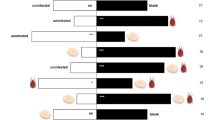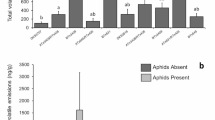Summary.
Bacteria species known to induce the biosynthesis of crucifer-specific phytoalexins have earlier been shown to be associated with Delia flies. Eleven crucifer-specific phytoalexins and related synthetic compounds were applied on surrogate paper leaves and offered to cabbage root flies in oviposition assays. Since three of these compounds (methoxybrassinin, cyclobrassinin, brassitin) proved to be significantly stimulatory whereas the remaining metabolites had no effect, the reaction of the fly appears to be structure-specific. Inactive phytoalexins had no inhibitory effect on oviposition. 100 μg of methoxybrassinin per surrogate leaf was as stimulatory as 0.05 gle (gram leaf equivalent) of a methanolic host-leaf (Brassica oleracea) extract. Thus the three active phytoalexins can explain only part of the activity of host-pant extracts but might induce a preference for infected plants.
Similar content being viewed by others
Author information
Authors and Affiliations
Additional information
Received 10 June 1998; accepted 27 August 1998.
Rights and permissions
About this article
Cite this article
Baur, R., Städler, E., Monde, K. et al. Phytoalexins from Brassica (Cruciferae) as oviposition stimulants for the cabbage root fly, Delia radicum. Chemoecology 8, 163–168 (1998). https://doi.org/10.1007/s000490050021
Issue Date:
DOI: https://doi.org/10.1007/s000490050021




